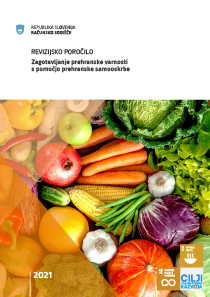The Court of Audit of the Republic of Slovenia audited efficiency of the Ministry of Agriculture, Forestry and Food (hereinafter referred to as: Ministry) in providing food safety in terms of food self-sufficiency in the Republic of Slovenia in the period from 1 January 2014 to 31 December 2020. The Court of Audit established that the Ministry was partially efficient.
Food safety of a country is provided by importing goods as well as by own production or self-sufficiency. The Republic of Slovenia is traditionally net agri-food products importer, while the largest deficit in 2019 was evident in meat, fruit, vegetables, cereal products, flour, starch or milk, and in the group of crop residue and food waste, feed.
The key condition for providing self-sufficiency is protection of the agricultural land. The land for agricultural use is defined by the municipalities in their spatial plans. Nevertheless, some plots of land which are not intended for agriculture in the spatial plans, can be used for carrying out agricultural activities. Between 2014 and 2019, there were 4,955 ha of land of non-agricultural use transferred to agricultural use, while at least twice as much of the land or 9,947 ha of agricultural land was transferred to other uses, whereby between 2014 and 2017, in most cases the use of the best agricultural land has changed.
The Ministry safeguarded agricultural land against land use change within spatial planning of the municipalities, but it fulfilled the last condition for starting the procedure of classifying permanently protected agricultural land only in July 2020, i.e. 9 years after enforcing the legal changes, which would enable the Ministry to safeguard 350,000 ha of the best agricultural land by the end of 2020. Therefore, no municipality in its spatial plan defined areas of permanently safeguarded agricultural land by the end of 2020. Permanently safeguarded agricultural land should not undergo changes, unless exception is made, for 10 years from the date of the land use classification.
In the period covered by the audit, the objectives regarding the scope of area covered by the agricultural land in use necessary for achieving the desired level of self-sufficiency were not set at all. Between 2015 and 2019, the agricultural land in use reduced by 1.8% or 11,120 ha which equals 40% of the area of the Municipality of Ljubljana.
The self-sufficiency level which should be achieved was defined by the Republic of Slovenia only for the production of vegetables (at least 50% of self-sufficiency) and rearing of pigs (70%), otherwise there were no clear objectives concerning the desired self-sufficiency levels. The Ministry addressed the reasons for poor self-sufficiency, namely weaknesses in transfer of knowledge, connecting producers and technological deterioration. Several different measures were considered referred to the disclosed reasons but the Ministry failed to implement them fully. The scope of the agricultural production could thus be influenced by the Ministry mainly through financial support. Yet, as the data show, there were no major changes in the levels of self-sufficiency between 2014 and 2019, except partially in the field of vegetables (from 37.8% to 43.7%).
Furthermore, on the basis of the payments to certain sectors which can be verified the Court of Audit established that in the current programming period the sectors where self-sufficiency is already high are most supported, namely livestock farming and animal products, which additionally increases the imbalance in the levels of self-sufficiency between the animal and plant products.
There are specific issues related to each sector, which were not appropriately addressed by the Ministry according to the opinion of the Court of Audit and which are presented in detail in the audit report.
The Court of Audit proposed to the Ministry several recommendations, but did not demand the submission of a response report.
All other documents are available only in the Slovenian language in the Slovenian site.





